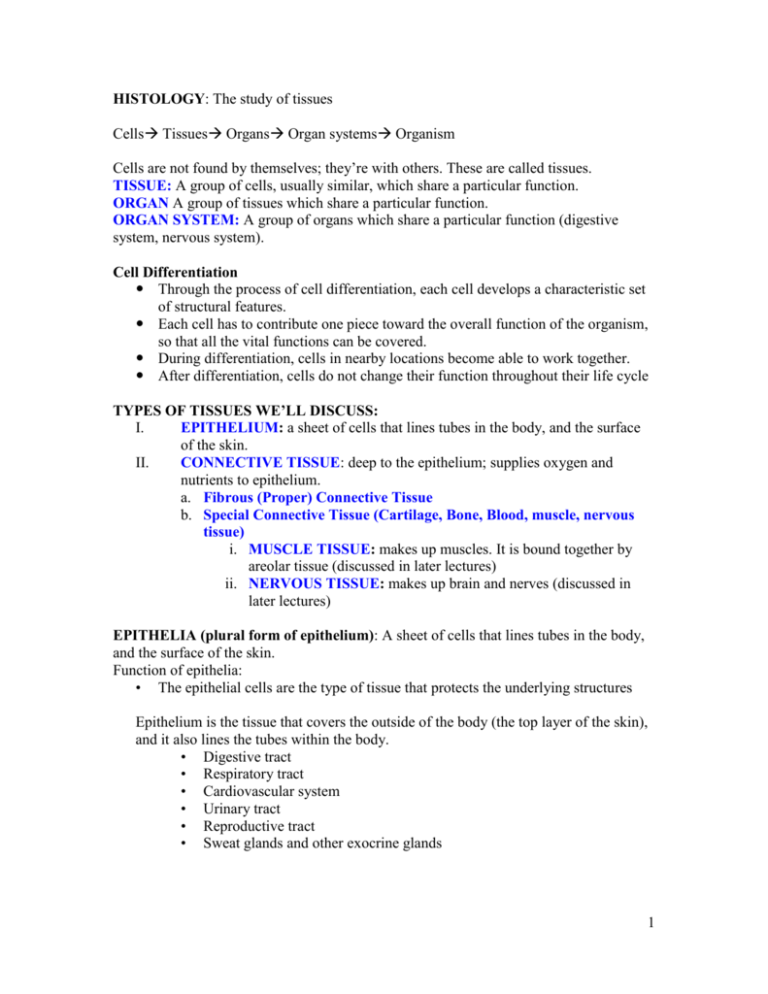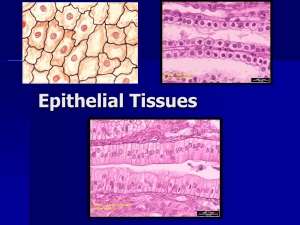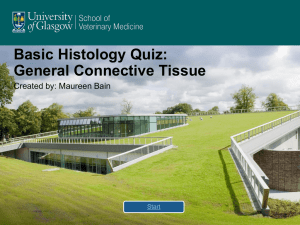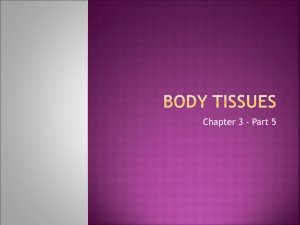This is a type of fiber that is found in all connective tissues (other
advertisement

HISTOLOGY: The study of tissues Cells Tissues Organs Organ systems Organism Cells are not found by themselves; they’re with others. These are called tissues. TISSUE: A group of cells, usually similar, which share a particular function. ORGAN A group of tissues which share a particular function. ORGAN SYSTEM: A group of organs which share a particular function (digestive system, nervous system). Cell Differentiation Through the process of cell differentiation, each cell develops a characteristic set of structural features. Each cell has to contribute one piece toward the overall function of the organism, so that all the vital functions can be covered. During differentiation, cells in nearby locations become able to work together. After differentiation, cells do not change their function throughout their life cycle TYPES OF TISSUES WE’LL DISCUSS: I. EPITHELIUM: a sheet of cells that lines tubes in the body, and the surface of the skin. II. CONNECTIVE TISSUE: deep to the epithelium; supplies oxygen and nutrients to epithelium. a. Fibrous (Proper) Connective Tissue b. Special Connective Tissue (Cartilage, Bone, Blood, muscle, nervous tissue) i. MUSCLE TISSUE: makes up muscles. It is bound together by areolar tissue (discussed in later lectures) ii. NERVOUS TISSUE: makes up brain and nerves (discussed in later lectures) EPITHELIA (plural form of epithelium): A sheet of cells that lines tubes in the body, and the surface of the skin. Function of epithelia: • The epithelial cells are the type of tissue that protects the underlying structures Epithelium is the tissue that covers the outside of the body (the top layer of the skin), and it also lines the tubes within the body. • Digestive tract • Respiratory tract • Cardiovascular system • Urinary tract • Reproductive tract • Sweat glands and other exocrine glands 1 Specialized Structures on Epithelium: Microvilli The presence of large numbers of microvilli on the exposed surfaces of epithelial cells indicates that this is the area where absorption and secretion take place. These cells are transportation specialists. They are probably located along portions of the digestive and urinary tracts The hollow space within each of these tubes is called a lumen. The lumens are always lined by epithelial cells. Epithelial cells Lumen of sweat gland All epithelia sit on top of connective tissue, and is connected to it by a BASEMENT MEMBRANE (which is not a cell membrane), made of protein fibers that connect to epithelium. The only function of the basement membrane is to attach the epithelium to the connective tissue beneath it. Epithelia get oxygen and nutrients from the blood vessels in the connective tissue beneath the basement membrane. Epithelium is always BIPOLAR: 1. APICAL SIDE: touches the space (inside heart, stomach, etc). 2. BASAL SIDE: touches the basement membrane 2 Different types of epithelium 1. SIMPLE EPITHELIUM has one cell layer. There are different types based on the shape of the cells. a. SIMPLE SQUAMOUS (the thinnest) EPITHELIUM is one layer of flat cells that allow diffusion of materials between the cells. This type of epithelium is in regions where a lot of diffusion is needed from one compartment to another, such as the lungs and a region in the kidney called the glomerulus. b. SIMPLE CUBOIDAL EPITHELIUM is cube shaped and is also found in areas where there is a lot of material going across from one compartment to another, but it has plenty of room for organelles. This epithelium is found in the region of the kidney called the convoluted tubules, and other places that need room for cell organelles. c. SIMPLE COLUMNAR EPITHELIUM is shaped like a column and is found in areas where the cells are needed for secretion and absorption (intestines). When they are differentiated into GOBLET CELLS, they produce mucus. d. PSEUDO-STRATIFIED EPITHELIUM is a single layer of cells that appears to be more than one layer thick, but it is not. The nucleus on one cell is at the top, and the nucleus of the next cell is at the bottom. Pseudostratified epithelium always has cilia on its apical surface. Each cilium is a hairlike structure that moves back and forth to move material in a certain direction. This type of epithelium needs goblet cells nearby to produce the mucus that contains the material to be swept. These cells will be found in the respiratory tract (the trachea), where the mucous catches the debris you inhale and the cilia sweeps the material up to your throat where you cough and swallow it. Its only functions are protection and mucous production. 3 2. STRATIFIED EPITHELIUM has more than one cell layer. The type of epithelium is named by the APICAL layer. a. STRATIFIED SQUAMOUS EPITHELIUM: the type is named by the apical cells. Stratified squamous epithelium is found in regions of the body where there is a lot of abrasions or wear-and tear, and it is protective. 1) KERATINIZED STRATIFIED SQUAMOUS EPITHELIUM has apical cells that contain a protein called keratin, which is waterproof. All of our dry skin is this type, and it is especially thick in the palms and soles. It is very good at resisting abrasions. 2) NON-KERATINIZED STRATIFIED SQUAMOUS EPITHELIUM does not have the keratin, so it will be moist skin, like what is found lining the mouth and esophagus. b. STRATIFIED CUBOIDAL EPITHELIUM usually consists of two layers, and there is almost no diffusion between them. They are found in sweat glands. 3. STRATIFIED COLUMNAR EPITHELIUM usually has just two layers and this type of epithelium inhibits diffusion of materials. It is relatively rare, providing protection along portions of the pharynx, urethra, and anus 4. TRANSITIONAL EPITHELIUM can stretch and change shape. This type is what lines the urinary bladder and it looks like this as it goes from empty to full. 4 CONNECTIVE TISSUES Types of Connective Tissues FIBROUS (PROPER) Connective tissues SPECIAL CONNECTIVE TISSUE Functions of Connective Tissues Defend the body from invasion by microorganisms Provide protection for delicate organs Establish a structural framework for the body FIBROUS (PROPER) Connective tissues 1. ADIPOSE- main cell type is adipocyte (stores fat) a. Functions: i. Cushions organs ii. Food Storage iii. Insulation 2. RETICULAR: Found in lymph nodes 3. LOOSE connective tissue (aka AREOLAR connective tissue) This is the least specialized type of connective tissue. The main cell type in loose and dense connective tissue is a FIBROBLAST (a type of cell, not just a part of a cell). Fibroblasts are what make collagen. Areolar is common in areas just deep to epithelium (upper dermis). It does NOT have much collagen because it does not have many fibroblasts. 5 4. DENSE REGULAR connective tissue Dense regular and irregular connective tissue has lots of COLLAGEN FIBERS Dense regular has more collagen than irregular. Dense regular fibers have a pattern, and run in same direction Even more strong than irregular, but only in one direction Found in ligaments, tendons. Note: tendons are not muscle tissue; they are dense regular connective tissue. NOTE: If you get injured, you’d rather break a bone than tear a ligament, why? The number of fibroblasts is the same, but the ligament has a lot more collagen to be made by each fibroblast. And the blood supply to bone is much better than a ligament. 5. DENSE IRREGULAR connective tissue a. Has lots of COLLAGEN FIBERS b. Fibers have irregular position; no pattern c. Extremely strong in all directions d. Found in areas of body where strength is needed (joint capsules and deeper layer of dermis). SPECIAL CONNECTIVE TISSUE 1. Cartilages a. Main cell type is CHONDROCYTE b. Extracellular matrix is dense collagen; almost solid, very rigid c. Avascular (no blood vessels. Torn cartilage won’t heal). d. There are three types of cartilage: i. HYALINE CARTILAGE (most joints) ii. ELASTIC CARTILAGE (ear) iii. FIBROCARTILAGE (intervertebral discs; resists compression forces) 2. Bone a. Extracellular matrix is solid, full of minerals (instead of fluid) b. Minerals are: Calcium carbonate and Calcium phosphate (same as limestone) c. Main cell type is OSTEOCYTE = “bone cell” i. Compact bone (shaft of long bones) ii. Spongy bone (ends of long bones) 3. Blood a. Main cell type is ERYTHROCYTE b. Extracellular matrix is the plasma (no collagen or elastin in blood) 6 Types of Membranes Synovial Membranes: This membrane lines the inside of fluid-filled joints. The cellular layers are incomplete, with gaps between adjacent cells to allow the fluid to escape into the joint to serve as a cushion. Mucous Membranes: Mucous membranes are covered in epithelium, which are involved in absorption and secretion. They line cavities that are exposed to the external environment and internal organs. They are located at the nostrils, the mouth, the lips, the eyelids, the ears, the genital area, and the anus. Serous Membranes: secrete a watery fluid. The fluid reduces friction from muscles or organs rubbing against each other. Its major function is to produce tiny amounts of transudate on their opposing surfaces to reduce friction. The serous membrane covering the heart is the pericardium. Inflammation here is called pericarditis. The serous membrane surrounding the lungs is the pleura. Inflammation here is called pleuritis. The serous membrane lining the abdominal cavity is the peritoneum. Inflammation here is called peritonitis. Another way to classify epithelium is by whether it is moist or dry. 1. MOIST EPITHELIUM: there are two types: a. MUCOSA is the cell type that produces mucous. Therefore, pseudo-stratified epithelium is a mucous epithelium, or a mucosa. b. SEROSA is an epithelium that has watery secretions on the surface. This is found in sweat glands. 2. DRY EPITHELIUM is keratinized stratified squamous epithelium. COLLAGEN This is a type of fiber that is found in all connective tissues (other than blood). It gives connective tissues an elastic consistency. It has very little blood supply, so it does not regenerate well. It does not interfere with diffusion of materials from one area to another; it just provides support for connective tissues. TYPES OF GLANDS • Exocrine Gland • Secretes substances into a duct and then excretes it onto the skin (e.g. sweat, oil) • Endocrine Gland • Secretes substances into the blood to be transported to another part of the body, where it is used (e.g. hormones). We will discuss endocrine glands in a separate lecture. 7 EXOCRINE GLANDS These are glands that produce a secretion which empties into a duct (tube). There are many different types and many ways to classify exocrine glands. 1. Classified based on the type of secretion a. SEROUS GLANDS secrete sweat. b. MUCOUS GLANDS secrete mucous, as found in goblet cells c. MIXED GLANDS secrete mucous and sweat, as found in salivary glands. d. OIL GLANDS secrete waxy and oily substances, as found in sebaceous glands. 2. Classified by the method of secretion a. MEROCRINE (Eccrine) GLANDS produce a secretion by a process called EXOCYTOSIS. The secretion vesicle moves to the plasma membrane, where it fuses and the material is released outside the cell. This is the process of most sweat glands and mucous glands. Functions of Merocrine glands Thermoregulation Inhibiting the growth of bacteria on the skin Excretion of water, electrolytes, and some drugs They do not function as a lubricant for the skin. b. APOCRINE GLANDS accumulate material in the apical section, the top of the cell breaks off, and the material is released. The cells that broke down will grow again. An example is the mammary gland. Apocrine glands are also considered to be a type of sweat gland. c. HOLOCRINE GLANDS are those where the entire cell breaks off with all the contents inside, such as sebaceous glands. After the cell breaks off, the other cells move in quickly and close up the gap. 8 3. Classified by their structure (what they look like) a. UNICELLULAR GLANDS, for example a goblet cell Goblet cells are found in the trachea and secrete mucous to trap debris; then you cough it up. Goblet cell b. MULTICELLULAR GLANDS Alveolar Simple alveolar Compound alveolar (mammary glands) Tubular Simple tubular (sweat glands) Compound tubular ALVEOLAR TUBULAR 9









